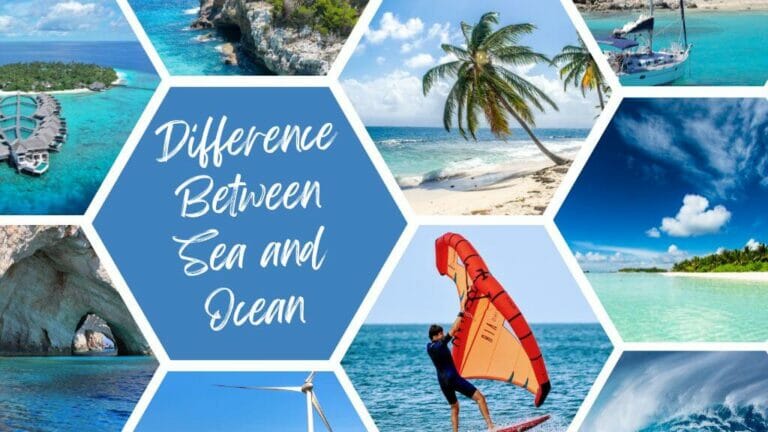Oceans and seas cover 70% of the Earth’s surface. The oceans and seas that makeup 96.5% of the 1.36 billion tons of water on Earth are where most of that water is stored. Geographically speaking, the oceans encircle most of the planet.
The difference between sea and ocean is that seas are large saline water bodies that are either connected to or unconnected from oceans. In contrast, oceans are enormous salty water bodies that occur on the surface of the Earth.
Let us learn the primary difference between sea and ocean below:
Table of Contents
What is a Sea?

A sea is a smaller body of water than an ocean. Typically, seas are fairly near land or human habitation, and the sea floor is composed of the continent’s light rock.
An enclosed body of water, such as the bodies of water seen on the map, might be referred to as a sea. The Mediterranean Sea, also known as the Great Sea, is a body of water linking southern Europe and Africa. It also connects 23 countries in Asia, Europe, and Africa and four territories.
A region of land usually partially encloses a sea since it is a smaller portion of an ocean. Because of this, all seas can be located where the ocean and land meet. Seas are generally surrounded by land.
Types of Sea
Sea is divided into 7 main types:
The modern Seven Seas include the Arctic, North Atlantic, South Atlantic, North Pacific, South Pacific, Indian, and Southern Oceans.
- North Atlantic Ocean: The region of the Atlantic Ocean is largely bounded by North America, Europe, and the northwest coast of Africa to the east and west, etc.
- South Atlantic Ocean: The South Atlantic Ocean is the region of the Atlantic Ocean that lies south of the equator and includes Antarctica.
- North Pacific Ocean: The northern portion of the Pacific Ocean, from the equator to the Arctic Ocean, is known as the North Pacific Ocean.
- South Pacific Ocean: The lower section of the Pacific Ocean, stretching from the equator to Antarctica, is known as the South Pacific Ocean.
- Arctic Ocean: It is considered as the smallest of the Seven Seas, the Arctic Ocean encircles the North Pole.
- Southern Ocean: The Southern Ocean, also called the Antarctic Ocean, comprises tributary seas and the southernmost reaches of the Pacific, Atlantic, and Indian oceans.
- Indian Ocean: The distance between the southernmost points of Africa and Australia is more than 6,200 miles (10,000 km).
What is an Ocean?

An ocean is a sizable saltwater body of water. Oceans are the bodies of water that divide continents, such as the Atlantic Ocean, the Indian Ocean from Africa, and the Pacific Ocean, which divides North and South America from Asia.
The oceans, which cover over two-thirds of the Earth’s surface and are composed of solid basaltic rock, are covered or surrounded by these oceans.
An ocean is a much larger body of open water compared to a sea. Three-fourths of the Earth’s surface is covered by the ocean, a huge volume of water. It absorbs colors from the sun, including greens, blues, grays, and lovely mixes of those hues.
The sun’s rays give it shades of green, blue, gray, and lovely mixes of those hues. It is infinite in supply and both stunning and lethal. It is the world’s largest body for storing water.
Numerous fish, aquatic creatures, and amphibians can be found beneath it.
Types of Oceans
5 primary oceans make up the World Ocean:
- Pacific Ocean: The Pacific Ocean, which connects Australia, Asia, and the western Americas, is the largest ocean in the world. Cape Horn in South America is where it intersects with the Atlantic Ocean.
- Atlantic Ocean: The Americas, West Africa, and Europe are encircled by this, the second-largest of the seas. The Atlantic Ocean and the Indian Ocean converge at Cape Agulhas in southern Africa.
- Indian Ocean: This is the third-largest of the oceans that encircle Southeast Asia, the Arabian Peninsula, and India.
- Arctic Ocean: The smallest of the five, it spans northward from Iceland and Greenland to the Atlantic Ocean. The Bering Strait also ties into the Pacific.
- Southern (Antarctic) Ocean: The second-smallest of the oceans is the Southern (Antarctic), a newly identified ocean division that encircles Antarctica. Depending on the season, it may be partially covered with ice, similar to the Arctic Ocean.
Learn more: What is the Difference Between Internal and International Migration?
Difference Between Sea and Ocean
The main difference between sea and ocean are below:
The sea and the ocean are very different. The difference between sea and ocean is that if a sizable body of saltwater is partially or entirely surrounded by land, we might say that it is considered a sea.
On the other hand, if a vast body of salt water spreads out unboundedly across the entire surface of the planet as a gigantic or dominant body, it is known as the ocean.
Another difference between sea and ocean is that the sea is smaller than the ocean. It is conceivable to access the sea bed for experiments, but it is nearly impossible to reach the ocean bed.
The primary difference between sea and ocean is that light can penetrate the sea floor, but not the ocean floor. Seas are typically close to land, whereas the oceans are limitless or unfathomable.
Sea Vs. Ocean
The comparison between sea vs. ocean are below:
1. Deepness

The comparison between sea vs. ocean is that oceans have a greater depth than seas since land typically encloses sea waters.
2. Area

Another comparison between ocean vs. sea is that the oceans are the largest bodies of water on Earth.
On the other hand, the Mediterranean Sea, the most immense sea, has a lesser extent than the smallest ocean, measuring 1,144,800 square miles. As a result, the area variation suggests that seas are smaller than oceans.
3. Marine Life

When it comes to marine life, both seas and oceans are numerous since seas are permanently encircled by land, but oceans are not. Oceans have less aquatic life since they are deeper than seas and farther from ground.
What is the Difference Between Sea and Ocean?
Highlighting the main difference between sea and ocean in the following table:
| Sea | Ocean |
|---|---|
| Sea is smaller in size. | Ocean is larger in size. |
| Sea covers less surface area of the Earth. | Ocean covers most of the surface area of the Earth. |
| The Sunlight can penetrate the sea floor. | The sunlight cannot penetrate the ocean floor. |
| Sea contains more aquatic life inside it. | Oceans have less aquatic life. |
Conclusion
The difference between sea and ocean is that the ocean is a sizable, saltwater body of open space. It holds 97 percent of the Earth’s water and covers around 71 percent of its surface. Because it is so big, barely 5% of it has been explored.
Large bodies of water are called seas that are encircled or partially confined by land. They are, in other words, the area of the ocean where dry land meets water.
Learn More: What is the Difference Between a Tux and a Suit?


